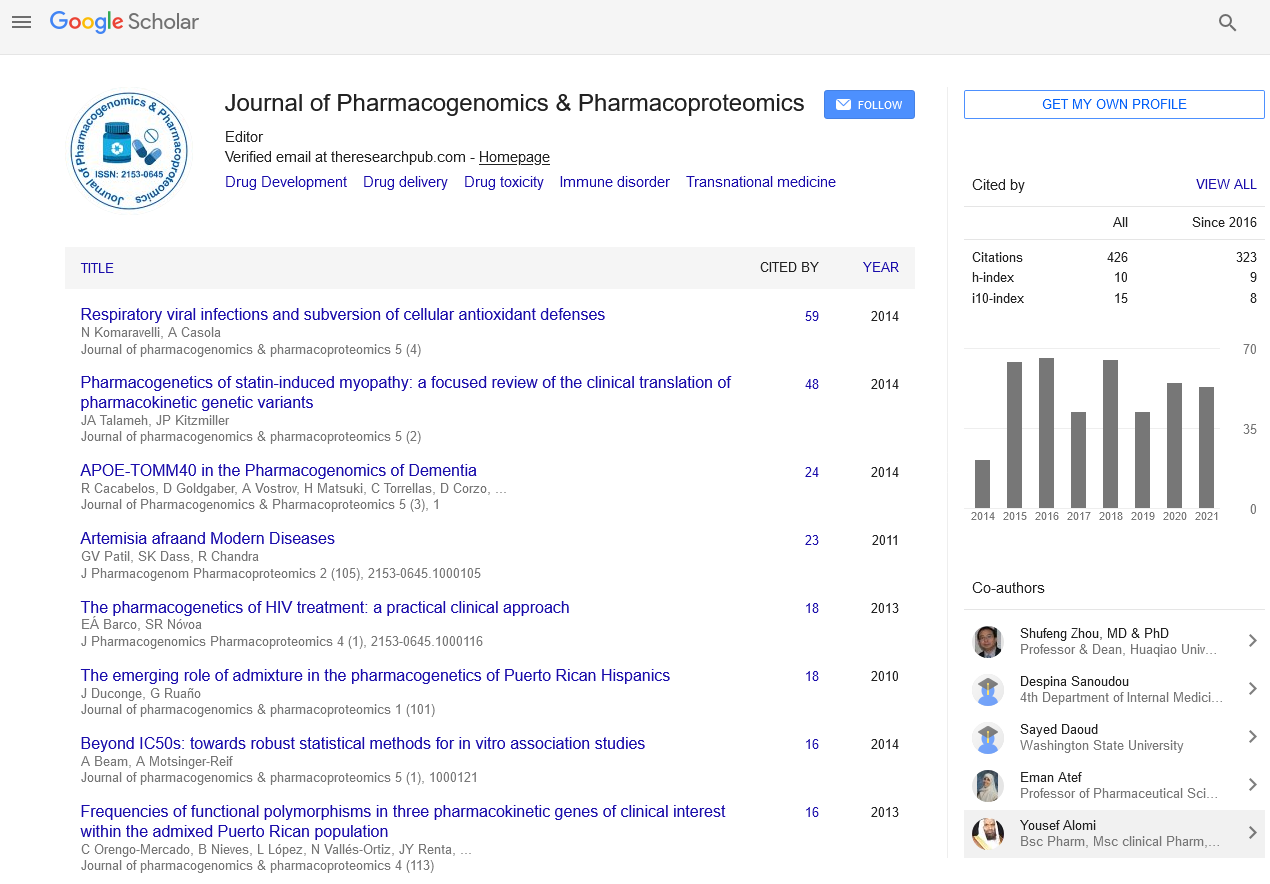Indexed In
- Open J Gate
- Genamics JournalSeek
- Academic Keys
- JournalTOCs
- ResearchBible
- Electronic Journals Library
- RefSeek
- Hamdard University
- EBSCO A-Z
- OCLC- WorldCat
- Proquest Summons
- SWB online catalog
- Virtual Library of Biology (vifabio)
- Publons
- MIAR
- Euro Pub
- Google Scholar
Useful Links
Share This Page
Journal Flyer

Open Access Journals
- Agri and Aquaculture
- Biochemistry
- Bioinformatics & Systems Biology
- Business & Management
- Chemistry
- Clinical Sciences
- Engineering
- Food & Nutrition
- General Science
- Genetics & Molecular Biology
- Immunology & Microbiology
- Medical Sciences
- Neuroscience & Psychology
- Nursing & Health Care
- Pharmaceutical Sciences
The influence of miRNA expression profiles after high-LET carbon ion irradiation on Tca-8113 cells
5th International Conference on Predictive, Preventive and Personalized Medicine & Molecular Diagnostics
December 01-02, 2016 Valencia, Spain
Xiangyi He, Songling HU, Qingfeng WU, Yuying LU, Jia GUO and Wenqiao GUO
School of Stomatology, Lanzhou University, China
Institute of Modern Physics, Chinese Academy of Sciences, China
Posters & Accepted Abstracts: J Pharmacogenomics Pharmacoproteomics
Abstract:
Objectives: The purposes of this study were to identify differently expressed microRNA (miRNA) after high-LET carbon ion irradiated human tongue squamous carcinoma Tca-8113 cells and to further study the miRNA roles in tumor radiotherapy. Methods: Total RNA was extracted from Tca-8113 cell after high-LET carbon ion irradiation. High throughput sequencing technique (HiSeq) was applied for detecting the differentially expressed genes (DEGs). The DEGs were divided into up-regulated and downregulated genes. Flow cytometry was used for detecting the cell apoptosis; qRT-PCR was used for verifying the results of HiSeq. Via bioinformatic analysis, the distribution of candidate target genes and the significant enriched GO-term genes were obtained in the Gene Oncology (GO); With KEGG pathway enrichment analysis, the main signal pathways which DEGs take part in were obtained. Results: High-LET carbon ion irradiation induced the apoptosis of Tca-8113 cell and a total of 13 miRNAs expression changed. Three up-regulated (miR-40, miR-53, miR-643) and 10 down-regulated miRNAs (miR-278, miR-353, miR-31, miR-375, miR-106, miR-577, etc) were identified in Tca-8113 cells by HiSeq after high-LET carbon ion irradiation. Furthermore, the consequence of qRT-PCR was basically the same as the HiSeq. Via GO function analysis, there were 23 GO-terms in biological process, 20 GO-terms in molecular function and 18 GO-terms in cellular component and so 86 KEGG pathways enriched which DEGs take part in. Conclusions: Our findings indicated that the high-LET carbon ion irradiation played a key role on miRNA expression of Tca-8113 cells and then these differentially expressed miRNA may become the potential molecular diagnostic biomarkers in tumor radiotherapy.
Biography :
Xiangyi He was graduated from School of Stomatology, Beijing University and has worked in Lanzhou University for 28 years. He was a Senior Visiting Scholar in University of Helsinki. He is currently a Member of CPCC, IADR, FDI and CSC and also a Reviewer of stamotological academic journals both domestic and aboard. His research focuses on oral ecology, oral microbiology, oral medicine and dentistry. He has published more than 80 articles in international academic journals and Chinese academic journals.
Email: hexy@lzu.edu.cn


